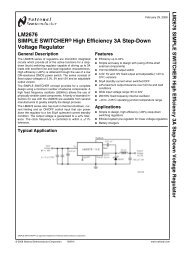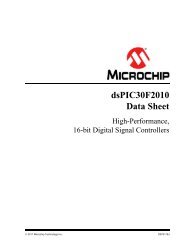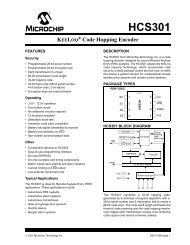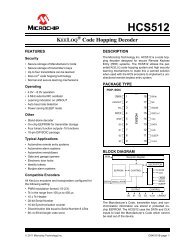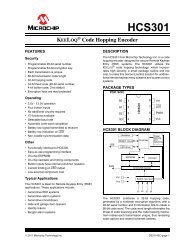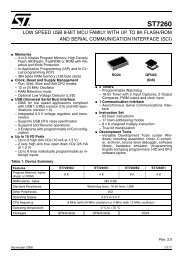AVR504: Migrating from ATtiny26 to ATtiny261 ... - Atmel Corporation
AVR504: Migrating from ATtiny26 to ATtiny261 ... - Atmel Corporation
AVR504: Migrating from ATtiny26 to ATtiny261 ... - Atmel Corporation
Create successful ePaper yourself
Turn your PDF publications into a flip-book with our unique Google optimized e-Paper software.
<strong>AVR504</strong>: <strong>Migrating</strong> <strong>from</strong> <strong>ATtiny26</strong> <strong>to</strong><br />
<strong>ATtiny26</strong>1/461/861<br />
Features<br />
• General Porting Considerations<br />
• Memories<br />
• System Clock and Clock Options<br />
• System Control and Reset<br />
• Registers<br />
• Interrupts<br />
• Timer/Counters<br />
• USI – Universal Serial Interface<br />
• Analogue-<strong>to</strong>-Digital Converter<br />
• I/O Ports<br />
• Memory Programming<br />
• Electrical Characteristics<br />
8-bit<br />
Microcontrollers<br />
Application Note<br />
1 Introduction<br />
This application note is a guide <strong>to</strong> assist users of <strong>ATtiny26</strong> in converting existing<br />
designs <strong>to</strong> <strong>ATtiny26</strong>1. The document will also assist <strong>ATtiny26</strong> users <strong>to</strong> migrate <strong>to</strong><br />
the ATtiny461 and ATtiny861 devices, which are members of the same family as<br />
the <strong>ATtiny26</strong>1, offering larger memories.<br />
In addition <strong>to</strong> the differences described in this document, the electrical<br />
characteristics of the devices are different. Some of these differences are outlined<br />
in this document and some are not. Please check the latest data sheets for detailed<br />
information.<br />
Improvements or added features in <strong>ATtiny26</strong>1 that are not in conflict with those in<br />
<strong>ATtiny26</strong> are not listed in this document.<br />
Rev. 8026B-AVR-04/08
2 General Porting Considerations<br />
Between the devices described in this application note, some registers and register<br />
bits have changed name but note that they preserve the same functionality. They are<br />
all listed later in this document.<br />
To make the porting process as easy as possible, always refer <strong>to</strong> registers and bit<br />
positions using their defined names. Avoid using absolute addresses and values. In<br />
most cases, the register and bit names are unchanged <strong>from</strong> device <strong>to</strong> device. When<br />
you are porting a design, it is more convenient <strong>to</strong> include the correct definition file for<br />
the new device, rather than manually changing all your addresses and bit values. It is<br />
also considered good programming practice <strong>to</strong> use named references instead of<br />
absolute values. Some examples are shown below.<br />
PORTB |= (1
<strong>AVR504</strong><br />
3.2 EEPROM<br />
EEPROM write access times depend on the frequency of the internal RC oscilla<strong>to</strong>r. In<br />
<strong>ATtiny26</strong>1/461/861 the access times are shorter than in <strong>ATtiny26</strong>.<br />
<strong>ATtiny26</strong>1 is part of a pin and functionally compatible subfamily of tinyAVR®, where<br />
the size of EEPROM ranges <strong>from</strong> 128 <strong>to</strong> 512 bytes. This means more than eight data<br />
bits are required for memory addressing and, therefore, the EEPROM address<br />
register has been expanded <strong>from</strong> one 8-bit register (EEAR in <strong>ATtiny26</strong>) <strong>to</strong> two<br />
(EEARL and EEARH in <strong>ATtiny26</strong>1, ATtiny461 and ATtiny861). Since the initial values<br />
of the registers are undefined it is important <strong>to</strong> always write both registers even when<br />
accessing only the bot<strong>to</strong>m section of the EEPROM.<br />
4 System Clock and Clock Options<br />
4.1 Clock Sources<br />
<strong>ATtiny26</strong>1/461/861 has a more advanced clock system than <strong>ATtiny26</strong>. In<br />
<strong>ATtiny26</strong>1/461/861 there is a system clock prescaler and two internal clock sources.<br />
Clock source options are set differently in <strong>ATtiny26</strong>1/461/861. See table below.<br />
Table 4-1. Clock Source Settings.<br />
<strong>ATtiny26</strong><br />
<strong>ATtiny26</strong>1/461/861<br />
Clocking Option PLLCK CKSEL[3:0] CKSEL[3:0] CLKPS[3…0]<br />
PLL 0 0001 0001 0000<br />
External Clock 1 0000 0000 0000<br />
Internal RC Oscilla<strong>to</strong>r, 1 MHz 1 0001 0011<br />
Internal RC Oscilla<strong>to</strong>r, 2 MHz 1 0010 0010<br />
0010<br />
Internal RC Oscilla<strong>to</strong>r, 4 MHz 1 0011 0001<br />
Internal RC Oscilla<strong>to</strong>r, 8 MHz 1 0100<br />
0000<br />
External RC Oscilla<strong>to</strong>r, 0.1…0.9 MHz 1 0101<br />
External RC Oscilla<strong>to</strong>r, 0.9…3.0 MHz 1 0110<br />
External RC Oscilla<strong>to</strong>r, 3.0…8.0 MHz 1 0111<br />
Not available, use internal RC<br />
oscilla<strong>to</strong>r instead<br />
External RC Oscilla<strong>to</strong>r, 8.0…12.0 MHz 1 1000<br />
External Low-Frequency Oscilla<strong>to</strong>r, 32.768 kHz 1 1001 01xx 0000<br />
External Resona<strong>to</strong>r Oscilla<strong>to</strong>r, 0.4…0.9 MHz<br />
1 1010 1000<br />
0000<br />
1 1011<br />
1001 0000<br />
External Crystal/Resona<strong>to</strong>r Oscilla<strong>to</strong>r, 0.9…3.0 MHz<br />
1 1100 1010<br />
0000<br />
1 1101<br />
1011 0000<br />
External Crystal/Resona<strong>to</strong>r Oscilla<strong>to</strong>r, 3.0…16.0 MHz<br />
1 1110 1100, 1101 0000<br />
1 1111<br />
1110, 1111 0000<br />
4.2 Calibration of Internal RC Oscilla<strong>to</strong>r<br />
8026B-AVR-04/08<br />
The frequency of the internal RC oscilla<strong>to</strong>r of <strong>ATtiny26</strong>1/461/861 can be calibrated<br />
using the OSCCAL register, similarly as in <strong>ATtiny26</strong>. The only difference is that in<br />
<strong>ATtiny26</strong>1/461/861 the highest bit (CAL7) determines the range of operation, while in<br />
3
4.3 High Frequency PLL Clock<br />
5 System Control and Reset<br />
5.1 Brown-Out Detection (BOD)<br />
<strong>ATtiny26</strong> all eight bits of the OSCCAL register are used <strong>to</strong> adjust the frequency within<br />
one, single range.<br />
When using the internal PLL as a clock source, <strong>ATtiny26</strong>1/461/861 applies a longer<br />
start-up delay than <strong>ATtiny26</strong> after a power-on reset and power-down wakeup. This is<br />
<strong>to</strong> ensure stable and glitch-free operation.<br />
<strong>ATtiny26</strong>1/461/861 has more fuse bits than <strong>ATtiny26</strong>. In addition, some fuse bits have<br />
a different functionality.<br />
Both <strong>ATtiny26</strong> and <strong>ATtiny26</strong>1/461/861 have programmable Brown-Out Detection<br />
levels. The programming method and levels are not entirely the same. See table<br />
below.<br />
Table 5-1. Brown-Out Detection (BOD) Characteristics.<br />
<strong>ATtiny26</strong><br />
<strong>ATtiny26</strong>1/461/861<br />
BODEN BODLEVEL V BOT BODLEVEL[2…0] V BOT<br />
1 X Disabled 111 Disabled<br />
0 4.0 V 100 4.3 V<br />
0<br />
1 2.7 V 101 2.7 V<br />
5.2 Start-up Times & Brown-out Detection<br />
Due <strong>to</strong> electrical differences between <strong>ATtiny26</strong> and <strong>ATtiny26</strong>1/461/861 there may be<br />
minor dissimilarities in start-up times. Please see device data sheets for more<br />
detailed information.<br />
5.3 Power-On Reset<br />
5.4 Watchdog Timer<br />
The threshold levels of power-on reset are not identical for <strong>ATtiny26</strong> and<br />
<strong>ATtiny26</strong>1/461/861. The power-on threshold voltage is slightly lower on<br />
<strong>ATtiny26</strong>1/461/861.<br />
Please see device data sheets for more detailed information.<br />
The <strong>ATtiny26</strong>1/461/861 includes an enhanced Watchdog Timer (WDT), compared <strong>to</strong><br />
the watchdog timer used in <strong>ATtiny26</strong>. At 5V operating voltage the WDT will behave<br />
similar on <strong>ATtiny26</strong> and <strong>ATtiny26</strong>1/461/861. At lower voltages the watchdog timeout<br />
interval may differ. Please see data sheet for characteristic data on watchdog<br />
oscilla<strong>to</strong>r frequency.<br />
If the WDT is not used, it is still recommended <strong>to</strong> disable it initially in the application<br />
code <strong>to</strong> clear unintentional WDT enabled events.<br />
4 <strong>AVR504</strong><br />
8026B-AVR-04/08
<strong>AVR504</strong><br />
6 Registers<br />
6.1 Renamed Registers<br />
Some of the register names have changed and some registers have moved.<br />
The below tables list the registers which have been renamed but still exist at the<br />
same physical address and have maintained their functionality. It is only required <strong>to</strong><br />
update the register name in the application.<br />
Table 6-1. Changes <strong>to</strong> Register Names.<br />
Address [hex] Name in <strong>ATtiny26</strong> Name in <strong>ATtiny26</strong>1/461/861<br />
0x06 ADCSR ADCSRA<br />
0x08 ACSR ACSRA<br />
0x1E EEAR EEARL<br />
0x1F - EEARH<br />
0x32 TCNT0 TCNT0L<br />
0x33 TCCR0 TCCR0B<br />
0x3D SP SPL<br />
6.2 Renamed Bits<br />
The below table lists the bits that have been renamed, but still exist in the same<br />
register and in the same register location.<br />
Table 6-2. Changes <strong>to</strong> Bit Names.<br />
<strong>ATtiny26</strong><br />
<strong>ATtiny26</strong>1/461/861<br />
Bit Name Register Address Bit Name<br />
ADFR ADCSR 0x06 ADATE<br />
USISIF USISR 0x0E USICIF<br />
EEMWE EECR 0x1C EEMPE<br />
EEWE EECR 0x1C EEPE<br />
6.3 Removed Bits<br />
The below table lists register bits, which have been removed and have no close<br />
replacements.<br />
5<br />
8026B-AVR-04/08
Table 6-3. <strong>ATtiny26</strong> Removed Register Bits and Functions.<br />
Register Name Register Bit Function<br />
TCCR1B CTC1 Resets Timer/Counter1<br />
7 Interrupts<br />
7.1 Interrupt Vec<strong>to</strong>rs<br />
7.2 Pin Change Interrupt<br />
Interrupt handling has been improved in <strong>ATtiny26</strong>1/461/861.<br />
<strong>ATtiny26</strong>1/461/861 has more interrupt vec<strong>to</strong>rs than <strong>ATtiny26</strong>, but all <strong>ATtiny26</strong> vec<strong>to</strong>rs<br />
exist in identical locations on <strong>ATtiny26</strong>1/461/861. Programs can still use the end of<br />
<strong>ATtiny26</strong> interrupt vec<strong>to</strong>r table as a starting address on <strong>ATtiny26</strong>1/461/861, provided<br />
that <strong>ATtiny26</strong>1/461/861 specific interrupts are not enabled.<br />
Pin change interrupts are au<strong>to</strong>matically disabled on <strong>ATtiny26</strong> if an alternative function<br />
has been enabled for the given pin. In <strong>ATtiny26</strong>1/461/861 this is not the case, where<br />
alternative pin functions and pin change interrupts may be concurrently enabled for<br />
the same pin. Pin change interrupts for a given pin in <strong>ATtiny26</strong>1/461/861 are masked<br />
and unmasked using Pin Change Mask Register A (PCMSKA) and Pin Change Mask<br />
Register B (PCMSKB).<br />
7.2.1 Source Pins and Masking<br />
<strong>ATtiny26</strong>1/461/861 extends pin change interrupts <strong>to</strong> cover all I/O pins, while <strong>ATtiny26</strong><br />
only includes pins PA3, PA6…7 and PB0…7. Also, <strong>ATtiny26</strong>1/461/861 allows<br />
individual masking of pin change interrupt sources via registers PCMSK0 and<br />
PCMSK1 (a feature not found in <strong>ATtiny26</strong>) but the default setting is <strong>to</strong> enable only<br />
those sources that are common for both <strong>ATtiny26</strong> and <strong>ATtiny26</strong>1/461/861.<br />
8 Timer/Counters<br />
8.1 Timer/Counter1<br />
Timer/Counter1 has been improved in <strong>ATtiny26</strong>1/461/861.<br />
In <strong>ATtiny26</strong>1/461/861 the synchronisation registers are not bypassed as in <strong>ATtiny26</strong>.<br />
This means a synchronisation delay of 1.5 clock cycles is present in both<br />
asynchronous and synchronous modes.<br />
8.1.1 Bit CTC1 of Register TCCR1B<br />
Bit CTC1 of register TCCR1B has been replaced by PWM1X on <strong>ATtiny26</strong>1/461/861.<br />
Please note that these bits have a different functionality and that this must be<br />
considered during migration.<br />
6 <strong>AVR504</strong><br />
8026B-AVR-04/08
<strong>AVR504</strong><br />
8.1.2 Register OCR1C<br />
8.1.3 PWM Mode<br />
Register OCR1C is now always the TOP value for the timer/counter and the register<br />
is always reset (cleared <strong>to</strong> zero) after reaching the TOP value.<br />
The lowest allowed TOP value is 3. If register OCR1C is loaded with a value lower<br />
than 3 it will be forced <strong>to</strong> the value 3. Also note that after a reset the OCR1C register<br />
is loaded with the timer/counter MAX value, which means that the default TOP value<br />
is 0x3FF.<br />
When writing <strong>to</strong> register OCR1C on <strong>ATtiny26</strong>1/461/861 the data is buffered and the<br />
register updated only when OCR1C has reached the TOP value. In <strong>ATtiny26</strong> writing<br />
<strong>to</strong> OCR1C is immediate.<br />
9 USI – Universal Serial Interface<br />
The <strong>ATtiny26</strong>1/461/861 uses an enhanced version of the Universal Serial Interface,<br />
as compared <strong>to</strong> the <strong>ATtiny26</strong>.<br />
9.1 Clock Sources<br />
The USI clock can be selected <strong>from</strong> three different sources, two of which are common<br />
for <strong>ATtiny26</strong> and <strong>ATtiny26</strong>1/461/861. The third clock source option (USICS[2:0] =<br />
01X) in <strong>ATtiny26</strong> is Timer/Counter0 Overflow, but in <strong>ATtiny26</strong>1/461/861 it has been<br />
replaced by Timer/Counter0 Compare Match. Similar functionality can be achieved<br />
but it may be necessary <strong>to</strong> update any parts of firmware that refer <strong>to</strong> Timer/Counter0<br />
overflow flags and interrupts.<br />
10 Analogue-<strong>to</strong>-Digital Converter<br />
10.1 Voltage Reference Selection<br />
The Analogue-<strong>to</strong>-Digital Converter (ADC) has been enhanced and in<br />
<strong>ATtiny26</strong>1/461/861 includes more features. <strong>ATtiny26</strong>1/461/861 is a 1.8V device and<br />
the default internal voltage reference is therefore set <strong>to</strong> 1.1V.<br />
Voltage reference source is selected using bits REFS2…0, located in registers<br />
ADMUX (ADC Multiplexer Selection) and ADCSRB (ADC Control and Status Register<br />
B). <strong>ATtiny26</strong> only includes bits REFS1…0. The table below shows how <strong>to</strong> update<br />
reference selection bits <strong>to</strong> maintain functionality.<br />
Table 10-1. Setting Voltage Reference Source.<br />
<strong>ATtiny26</strong><br />
<strong>ATtiny26</strong>1/461/861<br />
Voltage Reference<br />
REFS1…0 REFS2…0<br />
00 000 AVCC<br />
01 001 AREF (internal reference turned off)<br />
10 110 Internal 2.56V reference (AREF disconnected)<br />
11 111 Internal 2.56V reference (AREF connected)<br />
8026B-AVR-04/08<br />
7
11 I/O Ports<br />
Test limits for port drive strength are lower on <strong>ATtiny26</strong>1/461/861. This means<br />
<strong>ATtiny26</strong>1/461/861 ports are rated for a lower current than <strong>ATtiny26</strong>. Port driver<br />
characteristics are outlined in the table below.<br />
Table 11-1. Port Drive Characteristics.<br />
Condition<br />
Pin Rating [mA]<br />
Sum Rating [mA]<br />
<strong>ATtiny26</strong> <strong>ATtiny26</strong>1/461/861 <strong>ATtiny26</strong> <strong>ATtiny26</strong>1/461/861<br />
V CC = 5V 20 mA 10 mA<br />
V CC = 3V 10 mA 5 mA<br />
400 mA 60 mA<br />
12 Memory Programming<br />
12.1 Fuse Bits<br />
12.2 Signature Bytes<br />
Some modifications regarding the programming of fuse and calibration bytes msut be<br />
taken in<strong>to</strong> account. Also, the functionality of the calibration byte has been changed.<br />
The number of fuse bits has been increased and fuse bits are scattered over three<br />
bytes in <strong>ATtiny26</strong>1/461/861. Read and write algorithms must be updated for proper<br />
fuse programming.<br />
The functionality of the following fuse bits has changed:<br />
• The BODLEVEL fuse bit of <strong>ATtiny26</strong> has been expanded <strong>to</strong> three fuse bits<br />
(BODLEVEL2…0) on <strong>ATtiny26</strong>1/461/861.<br />
• The BODEN fuse bit functionality of <strong>ATtiny26</strong> has been integrated in<strong>to</strong><br />
BODLEVEL2…0 fuse bits of <strong>ATtiny26</strong>1/461/861.<br />
• The PLLCK and CKOPT fuse bit functionality of <strong>ATtiny26</strong> has been integrated in<strong>to</strong><br />
CKSEL3…0 fuse bits of <strong>ATtiny26</strong>1/461/861.<br />
• Clock prescaler functionality of CKSEL fuses has been removed, since<br />
<strong>ATtiny26</strong>1/461/861 has a software configurable clock prescaler.<br />
Signature bytes reside in a separate address space and can only be read external <strong>to</strong><br />
the device. Therefore, this notion only applies <strong>to</strong> programmers, et al, and not <strong>to</strong> the<br />
actual program being migrated.<br />
Signature bytes have been updated as illustrated in the table below.<br />
Table 12-1. Summary of Signature Bytes.<br />
Byte <strong>ATtiny26</strong> <strong>ATtiny26</strong>1 ATtiny461 ATtiny861<br />
$000 $1E $1E $1E $1E<br />
$001 $91 $91 $92 $93<br />
$002 $09 $0C $08 $0D<br />
8 <strong>AVR504</strong><br />
8026B-AVR-04/08
<strong>AVR504</strong><br />
12.3 Calibration Byte<br />
<strong>ATtiny26</strong> has four calibration bytes for the 1MHz, 2MHz, 4MHz and 8MHz operation<br />
of the internal RC oscilla<strong>to</strong>r. <strong>ATtiny26</strong>1/461/861 only has one calibration byte for the<br />
internal RC oscilla<strong>to</strong>r.<br />
13 Electrical Characteristics<br />
<strong>ATtiny26</strong>1/461/861 is manufactured using a different process than <strong>ATtiny26</strong> and<br />
electrical characteristics will therefore differ between these devices. Please consult<br />
the data sheets for details on electrical characteristics.<br />
8026B-AVR-04/08<br />
9
Disclaimer<br />
Headquarters<br />
International<br />
<strong>Atmel</strong> <strong>Corporation</strong><br />
2325 Orchard Parkway<br />
San Jose, CA 95131<br />
USA<br />
Tel: 1(408) 441-0311<br />
Fax: 1(408) 487-2600<br />
<strong>Atmel</strong> Asia<br />
Room 1219<br />
Chinachem Golden Plaza<br />
77 Mody Road Tsimshatsui<br />
East Kowloon<br />
Hong Kong<br />
Tel: (852) 2721-9778<br />
Fax: (852) 2722-1369<br />
<strong>Atmel</strong> Europe<br />
Le Krebs<br />
8, Rue Jean-Pierre Timbaud<br />
BP 309<br />
78054 Saint-Quentin-en-<br />
Yvelines Cedex<br />
France<br />
Tel: (33) 1-30-60-70-00<br />
Fax: (33) 1-30-60-71-11<br />
<strong>Atmel</strong> Japan<br />
9F, Tonetsu Shinkawa Bldg.<br />
1-24-8 Shinkawa<br />
Chuo-ku, Tokyo 104-0033<br />
Japan<br />
Tel: (81) 3-3523-3551<br />
Fax: (81) 3-3523-7581<br />
Product Contact<br />
Web Site<br />
www.atmel.com<br />
Technical Support<br />
avr@atmel.com<br />
Sales Contact<br />
www.atmel.com/contacts<br />
Literature Request<br />
www.atmel.com/literature<br />
Disclaimer: The information in this document is provided in connection with <strong>Atmel</strong> products. No license, express or implied, by es<strong>to</strong>ppel or otherwise, <strong>to</strong> any<br />
intellectual property right is granted by this document or in connection with the sale of <strong>Atmel</strong> products. EXCEPT AS SET FORTH IN ATMEL’S TERMS AND<br />
CONDITIONS OF SALE LOCATED ON ATMEL’S WEB SITE, ATMEL ASSUMES NO LIABILITY WHATSOEVER AND DISCLAIMS ANY EXPRESS, IMPLIED<br />
OR STATUTORY WARRANTY RELATING TO ITS PRODUCTS INCLUDING, BUT NOT LIMITED TO, THE IMPLIED WARRANTY OF MERCHANTABILITY,<br />
FITNESS FOR A PARTICULAR PURPOSE, OR NON-INFRINGEMENT. IN NO EVENT SHALL ATMEL BE LIABLE FOR ANY DIRECT, INDIRECT,<br />
CONSEQUENTIAL, PUNITIVE, SPECIAL OR INCIDENTAL DAMAGES (INCLUDING, WITHOUT LIMITATION, DAMAGES FOR LOSS OF PROFITS,<br />
BUSINESS INTERRUPTION, OR LOSS OF INFORMATION) ARISING OUT OF THE USE OR INABILITY TO USE THIS DOCUMENT, EVEN IF ATMEL HAS<br />
BEEN ADVISED OF THE POSSIBILITY OF SUCH DAMAGES. <strong>Atmel</strong> makes no representations or warranties with respect <strong>to</strong> the accuracy or completeness of the<br />
contents of this document and reserves the right <strong>to</strong> make changes <strong>to</strong> specifications and product descriptions at any time without notice. <strong>Atmel</strong> does not make any<br />
commitment <strong>to</strong> update the information contained herein. Unless specifically provided otherwise, <strong>Atmel</strong> products are not suitable for, and shall not be used in,<br />
au<strong>to</strong>motive applications. <strong>Atmel</strong>’s products are not intended, authorized, or warranted for use as components in applications intended <strong>to</strong> support or sustain life.<br />
© 2008 <strong>Atmel</strong> <strong>Corporation</strong>. All rights reserved. <strong>Atmel</strong>®, logo and combinations thereof, and others, are the registered trademarks or<br />
trademarks of <strong>Atmel</strong> <strong>Corporation</strong> or its subsidiaries. Other terms and product names may be trademarks of others.<br />
8026B-AVR-04/08





